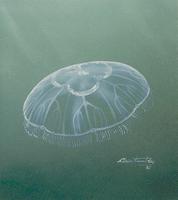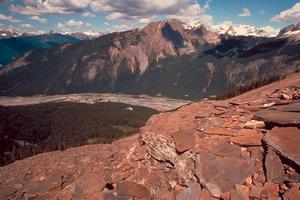Palaeontology is the study of FOSSILS, gives us knowledge of past life, helps us understand the nature of ancient organisms and provides information about the composition of the biomass of past times. The organisms now living represent a stage in the succession of life forms and, according to the concept of EVOLUTION, have descended from past life forms. It is difficult to estimate how many species now exist; the number may be in excess of 45 million. Some authorities estimate that 1.5 million living species (monerans, protistans, fungi, plants and animals) have actually been found and described.
Fossil Record
The fossil record, largely representing the past 600 million years, has been estimated to contain about 250 000 species, a low figure since new species are constantly being described. Nevertheless, the actual number of species represented in the fossil record is low (possibly as low as 5%) compared to the number of species living today, because not all organisms have an equal chance of being preserved as fossils, eg, the delicate bodies of insects.
In exceptional circumstances, soft-bodied animals may be preserved, eg, the bodies of organisms very quickly buried in sediment. Canada is fortunate in having one of the most famous faunas of this type, British Columbia's Cambrian BURGESS SHALE, first discovered by C.D. Walcott (1909). The Burgess Shale fauna is of great interest to palaeontologists because of the unique state of preservation and variety of organisms represented (more than 120 species of soft-bodied marine animals).
By far the greatest proportion of fossils is of animals that had hard skeletal parts. The groups most commonly represented in the fossil record are the protozoans, Archaeocyathids (now extinct), Porifera (SPONGES), Coelenterates (CORALS), Bryozoa, BRACHIOPODS, MOLLUSCS (clams, nautiloids), arthropods (TRILOBITES) and ECHINODERMS (crinoids, echinoids). Various minerals have been and are being used by animals for skeletal construction (eg, chitin, calcium carbonate, silica and calcium phosphate).
Once an organism dies, its body is incorporated in the sediment and subjected to groundwaters percolating through the area. Such solutions can have dramatic effects on the buried organism. In some cases, the skeletal material is removed completely, leaving no trace of the organism. In other instances, new minerals such as silica are precipitated into pore spaces within the skeleton, thereby increasing its weight. TREE material and bones (eg, DINOSAUR bones found around Drumheller, Alberta) are commonly preserved in this manner. In another common process, the entire original skeletal material is replaced by a new mineral. Other fossils occur simply as a carbon residue on the surface of rock, the carbon remaining after the more volatile materials have been removed. Fossil plants and graptolites (Palaeozoic colonial animals) are commonly preserved in this manner.
Fossil Classification
The fossil record encompasses a tremendous variety of organisms, ranging from microscopic conodonts to the giants of the fossil world, the dinosaurs. Obviously, there is a need to order the organisms, placing related organisms in groups. This process of classification was initiated by Aristotle, who recognized the differences between major groups, eg, birds and insects.
The classification scheme now used by all palaeontologists is that proposed by the 18th-century Swedish naturalist Linnaeus. This hierarchical system divides organisms into kingdoms, phyla, classes, orders, families, genera and species. The names attached to each division are associated with a particular group of organisms; therefore, they show relationships among organisms. The most commonly used part of the system is the "binomial designation," eg, the 2-part name Tyrannosaurus rex implies that the species name is rex and that it belongs to the genus Tyrannosaurus. The name Tyrannosaurus rex should immediately convey the nature of the beast being described, in this case a large dinosaur - the "king of the terrible lizards."
Study of Fossils
The study of fossils has many important applications in a wide variety of fields. For example, the study of the fossil record can give insight about when and in what form life first appeared on Earth. The oldest known fossils are thought to be remains of ALGAE, bacteria and possibly fungi, which have been fortuitously preserved in cherts of Precambrian age. For example, the "Fig Tree" chert from South Africa contains algae which are considered to be more than 3.2 billion years old. A famous locality in Canada, the "Gunflint" chert exposed in southern Ontario, has yielded bacteria and algae that are about 1.9 billion years old. Stromatolites, structures formed by algae, are also common in Precambrian rocks dating back to about 2.8 billion years ago. Such stromatolites are quite common in Canadian Precambrian rocks.
The fossil record can also help the palaeontologist to pinpoint various important stages in the evolution of life. For example, it shows that life during Precambrian times (before 570 million years ago) was entirely soft bodied. At the beginning of Cambrian times (between 570 and 505 million years ago) organisms developed the ability to secrete hard skeletons. It is through the fossil record that it is known that the Palaeozoic era was the time when INVERTEBRATE animals dominated the biomass. Similarly, the fossil record reveals the dominance of the dinosaurs during the Mesozoic era (between 245 and 66.4 million years ago) and the MAMMALS during the Cenozoic (66.4 million years ago to the present).
From the fossil record, it can also be shown that groups of animals have become extinct. Charles Darwin made extensive studies of fossils in the strata of South America and used this information along with data from modern species to formulate his theory of evolution. The fossil record also permits the study of the ecology of past times by describing the environment in which an organism lived and the interrelationship of the different groups of organisms present (seeBIOGEOGRAPHY).
Perhaps the most important use of fossils is for the relative dating of the rocks in which they occur. It was demonstrated in the 19th century that a distinct succession of fossils will be found in any given sequence of sedimentary rock layers (horizons) and that rocks of a particular age will contain particular types of fossil. This discovery led to the development of biostratigraphy, literally, the tying together of rock units on the basis of their biological content. The principle follows from Darwin's concept of evolution: life changes gradually with time, and once a species has become extinct it will not reappear. As a basic tool in deciphering the geological evolution of an area, biostratigraphy has widespread economic application, playing an integral role in the exploration for oil, gas and minerals. In Canada, many important PETROLEUM discoveries have been based on detailed biostratigraphical studies.
See alsoGEOLOGY; PALYNOLOGY.

 Share on Facebook
Share on Facebook Share on X
Share on X Share by Email
Share by Email Share on Google Classroom
Share on Google Classroom









